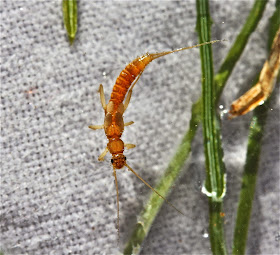Twenty inches of snow in one week, with morning temps in the single digits and teens: February in a nutshell, this February at least. So with the sun out this morning and more snow and cold on the way, can you blame me for trying to get out to a stream? Alas, you can see what I found when I got to Buck Mt. Creek: I needed my ice skates instead of my boots!
The problem is we're missing a lot of beautiful insects that are close to, or already fully, mature. E.g. just look what I've seen in previous years at this time. A sampler.
1. Giant stoneflies
Pteronarcys biloba (Rapidan River): 2/17/12
Pteronarcys proteus (Sugar Hollow): 2/13/12
2. Perlodid stoneflies
Helopicus subvarians (Buck Mt. Creek): 2/6/12
Clioperla clio (Buck Mt. Creek): 2/17/12
Malirekus hastatus (Sugar Hollow): 2/13/12
Isoperla similis (Rapdian River): 2/24/14
3. Nemourid stoneflies
Prostoia completa (Buck Mt. Creek): 3/1/11
4. Large winter stoneflies
Taenionema atlanticum (Sugar Hollow): 2/2/12
Strophopteryx fasciata (Buck Mt. Creek): 2/6/12
4. Small winter stonefly
Paracapnia angulata (Sugar Hollow): 1/30/12
5. Small minnow mayflies
Heterocloen amplum (Doyles River): 2/6/12
Heterocloen amplum (Doyles River): 2/17/13
and Baetis tricaudatus (Rapidan River): 1/18/12
Baetis tricaudatus (Rapidan River): 2/24/12
What a pity. Let's hope for warm weather and sunshine in March -- which starts on Sunday! Until then, the "treasure hunt" is on hold.
























